tow SKODA ROOMSTER 2012 1.G Service Manual
[x] Cancel search | Manufacturer: SKODA, Model Year: 2012, Model line: ROOMSTER, Model: SKODA ROOMSTER 2012 1.GPages: 194, PDF Size: 4.8 MB
Page 158 of 194
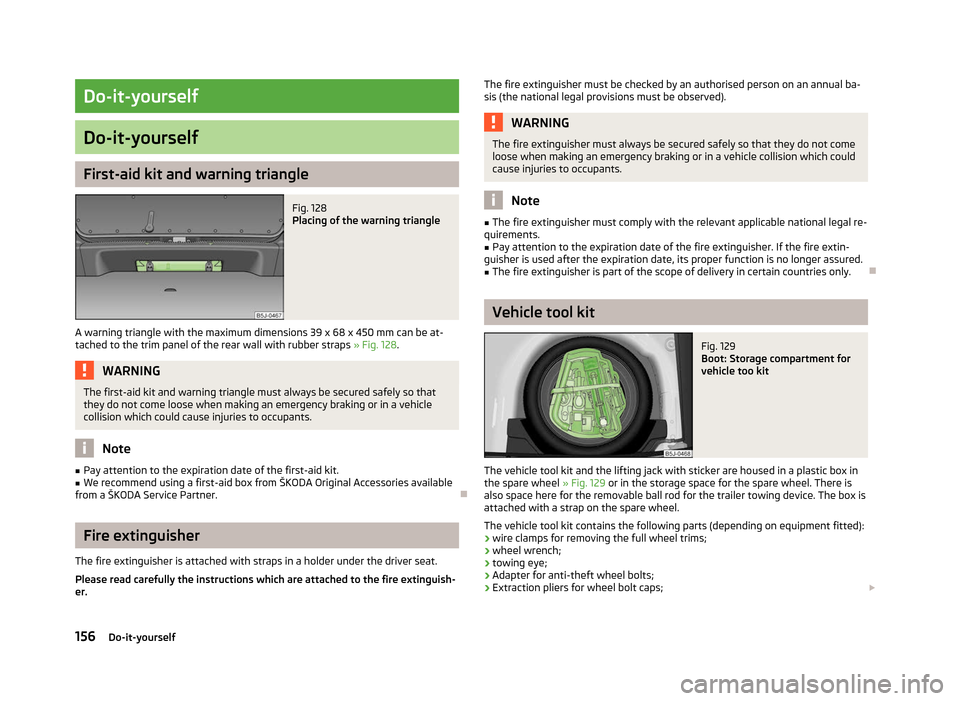
Do-it-yourself
Do-it-yourself
First-aid kit and warning triangle
Fig. 128
Placing of the warning triangle
A warning triangle with the maximum dimensions 39 x 68 x 450 mm can be at-
tached to the trim panel of the rear wall with rubber straps » Fig. 128.WARNING
The first-aid kit and warning triangle must always be secured safely so that
they do not come loose when making an emergency braking or in a vehicle
collision which could cause injuries to occupants. Note
■ Pay attention to the expiration date of the first-aid kit.
■ We recommend using a first-aid box from ŠKODA Original Accessories available
from a ŠKODA Service Partner. ÐFire extinguisher
The fire extinguisher is attached with straps in a holder under the driver seat.
Please read carefully the instructions which are attached to the fire extinguish-
er. The fire extinguisher must be checked by an authorised person on an annual ba-
sis (the national legal provisions must be observed). WARNING
The fire extinguisher must always be secured safely so that they do not come
loose when making an emergency braking or in a vehicle collision which could
cause injuries to occupants. Note
■ The fire extinguisher must comply with the relevant applicable national legal re-
quirements. ■ Pay attention to the expiration date of the fire extinguisher. If the fire extin-
guisher is used after the expiration date, its proper function is no longer assured.
■ The fire extinguisher is part of the scope of delivery in certain countries only. Ð Vehicle tool kit
Fig. 129
Boot: Storage compartment for
vehicle too kit
The vehicle tool kit and the lifting jack with sticker are housed in a plastic box in
the spare wheel » Fig. 129 or in the storage space for the spare wheel. There is
also space here for the removable ball rod for the trailer towing device. The box is
attached with a strap on the spare wheel.
The vehicle tool kit contains the following parts (depending on equipment fitted):
› wire clamps for removing the full wheel trims;
› wheel wrench;
› towing eye;
› Adapter for anti-theft wheel bolts;
› Extraction pliers for wheel bolt caps;
£
156 Do-it-yourself
Page 160 of 194
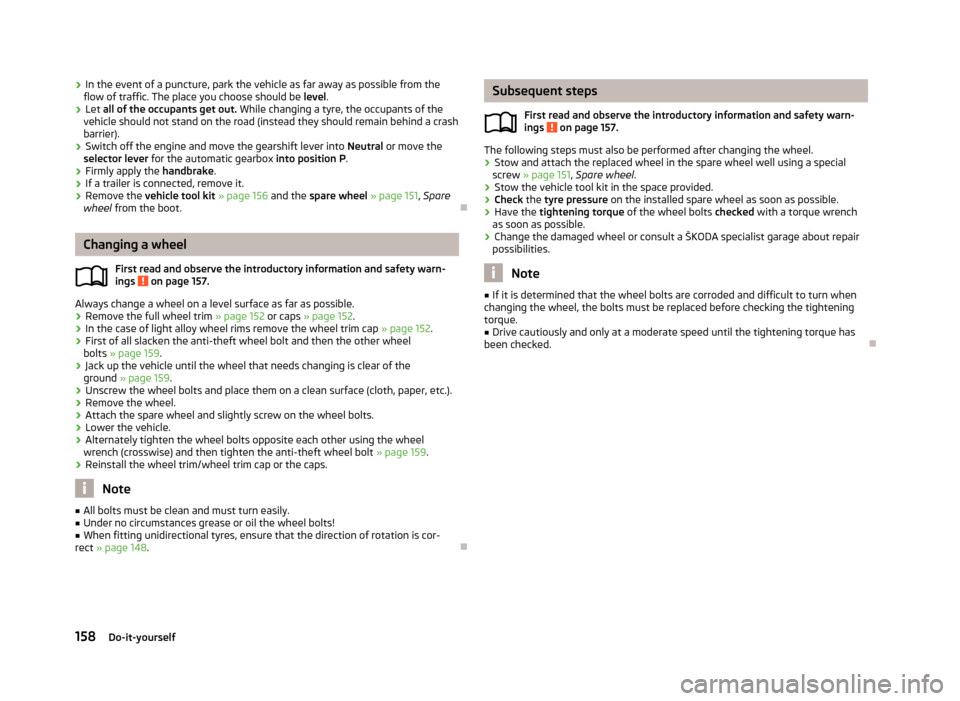
›
In the event of a puncture, park the vehicle as far away as possible from the
flow of traffic. The place you choose should be level.
› Let all of the occupants get out.
While changing a tyre, the occupants of the
vehicle should not stand on the road (instead they should remain behind a crash
barrier).
› Switch off the engine and move the gearshift lever into
Neutral or move the
selector lever for the automatic gearbox into position P .
› Firmly apply the
handbrake.
› If a trailer is connected, remove it.
› Remove the vehicle tool kit
» page 156 and the spare wheel » page 151, Spare
wheel from the boot. ÐChanging a wheel
First read and observe the introductory information and safety warn-
ings on page 157.
Always change a wheel on a level surface as far as possible.
›
Remove the full wheel trim
» page 152 or caps » page 152.
› In the case of light alloy wheel rims remove the wheel trim cap
» page 152.
› First of all slacken the anti-theft wheel bolt and then the other wheel
bolts » page 159.
› Jack up the vehicle until the wheel that needs changing is clear of the
ground » page 159.
› Unscrew the wheel bolts and place them on a clean surface (cloth, paper, etc.).
› Remove the wheel.
› Attach the spare wheel and slightly screw on the wheel bolts.
› Lower the vehicle.
› Alternately tighten the wheel bolts opposite each other using the wheel
wrench (crosswise) and then tighten the anti-theft wheel bolt » page 159.
› Reinstall the wheel trim/wheel trim cap or the caps. Note
■ All bolts must be clean and must turn easily.
■ Under no circumstances grease or oil the wheel bolts!
■ When fitting unidirectional tyres, ensure that the direction of rotation is cor-
rect »
page 148 . Ð
ä Subsequent steps
First read and observe the introductory information and safety warn-
ings on page 157.
The following steps must also be performed after changing the wheel.
›
Stow and attach the replaced wheel in the spare wheel well using a special
screw » page 151, Spare wheel.
› Stow the vehicle tool kit in the space provided.
› Check
the tyre pressure
on the installed spare wheel as soon as possible.
› Have the
tightening torque of the wheel bolts checked with a torque wrench
as soon as possible.
› Change the damaged wheel or consult a ŠKODA specialist garage about repair
possibilities. Note
■ If it is determined that the wheel bolts are corroded and difficult to turn when
changing the wheel, the bolts must be replaced before checking the tightening
torque. ■ Drive cautiously and only at a moderate speed until the tightening torque has
been checked. Ð
ä
158 Do-it-yourself
Page 162 of 194
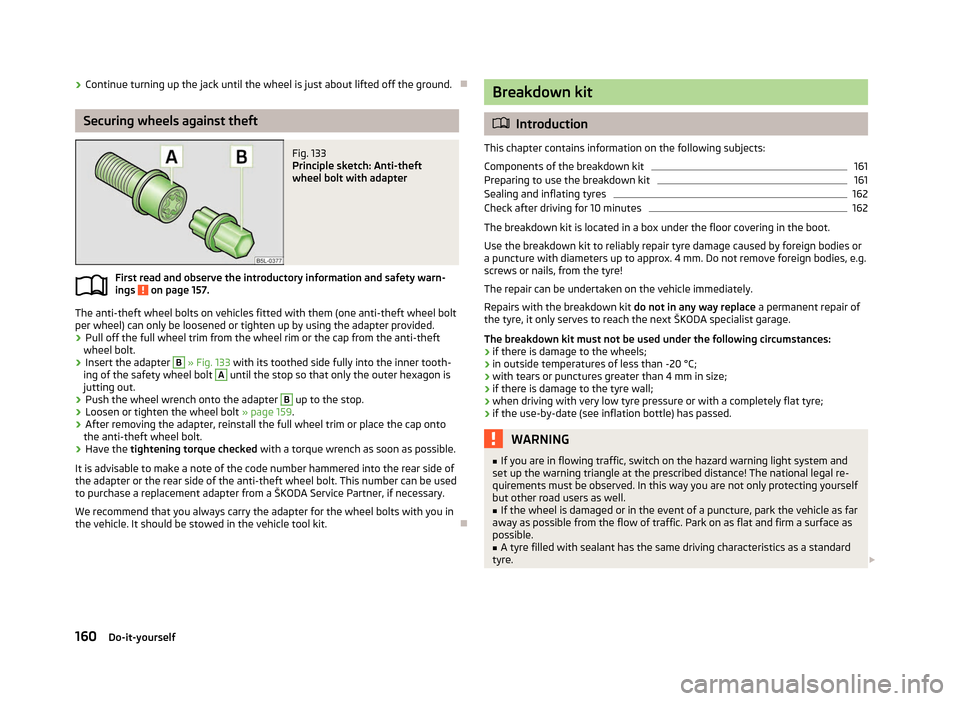
›
Continue turning up the jack until the wheel is just about lifted off the ground. ÐSecuring wheels against theft
Fig. 133
Principle sketch: Anti-theft
wheel bolt with adapter
First read and observe the introductory information and safety warn-
ings on page 157.
The anti-theft wheel bolts on vehicles fitted with them (one anti-theft wheel bolt
per wheel) can only be loosened or tighten up by using the adapter provided.
›
Pull off the full wheel trim from the wheel rim or the cap from the anti-theft
wheel bolt.
› Insert the adapter B
» Fig. 133 with its toothed side fully into the inner tooth-
ing of the safety wheel bolt A
until the stop so that only the outer hexagon is
jutting out.
› Push the wheel wrench onto the adapter B
up to the stop.
› Loosen or tighten the wheel bolt
» page 159.
› After removing the adapter, reinstall the full wheel trim or place the cap onto
the anti-theft wheel bolt.
› Have the
tightening torque checked with a torque wrench as soon as possible.
It is advisable to make a note of the code number hammered into the rear side of
the adapter or the rear side of the anti-theft wheel bolt. This number can be used
to purchase a replacement adapter from a
ŠKODA Service Partner, if necessary.
We recommend that you always carry the adapter for the wheel bolts with you in
the vehicle. It should be stowed in the vehicle tool kit. Ð
ä Breakdown kit
ä
Introduction
This chapter contains information on the following subjects:
Components of the breakdown kit 161
Preparing to use the breakdown kit 161
Sealing and inflating tyres 162
Check after driving for 10 minutes 162
The breakdown kit is located in a box under the floor covering in the boot.
Use the breakdown kit to reliably repair tyre damage caused by foreign bodies or
a puncture with diameters up to approx. 4
mm. Do not remove foreign bodies, e.g.
screws or nails, from the tyre!
The repair can be undertaken on the vehicle immediately.
Repairs with the breakdown kit do not in any way replace a permanent repair of
the tyre, it only serves to reach the next ŠKODA specialist garage.
The breakdown kit must not be used under the following circumstances:
› if there is damage to the wheels;
› in outside temperatures of less than -20 °C;
› with tears or punctures greater than 4 mm in size;
› if there is damage to the tyre wall;
› when driving with very low tyre pressure or with a completely flat tyre;
› if the use-by-date (see inflation bottle) has passed. WARNING
■ If you are in flowing traffic, switch on the hazard warning light system and
set up the warning triangle at the prescribed distance! The national legal re-
quirements must be observed. In this way you are not only protecting yourself
but other road users as well.
■ If the wheel is damaged or in the event of a puncture, park the vehicle as far
away as possible from the flow of traffic. Park on as flat and firm a surface as
possible. ■ A tyre filled with sealant has the same driving characteristics as a standard
tyre. £
160 Do-it-yourself
Page 166 of 194
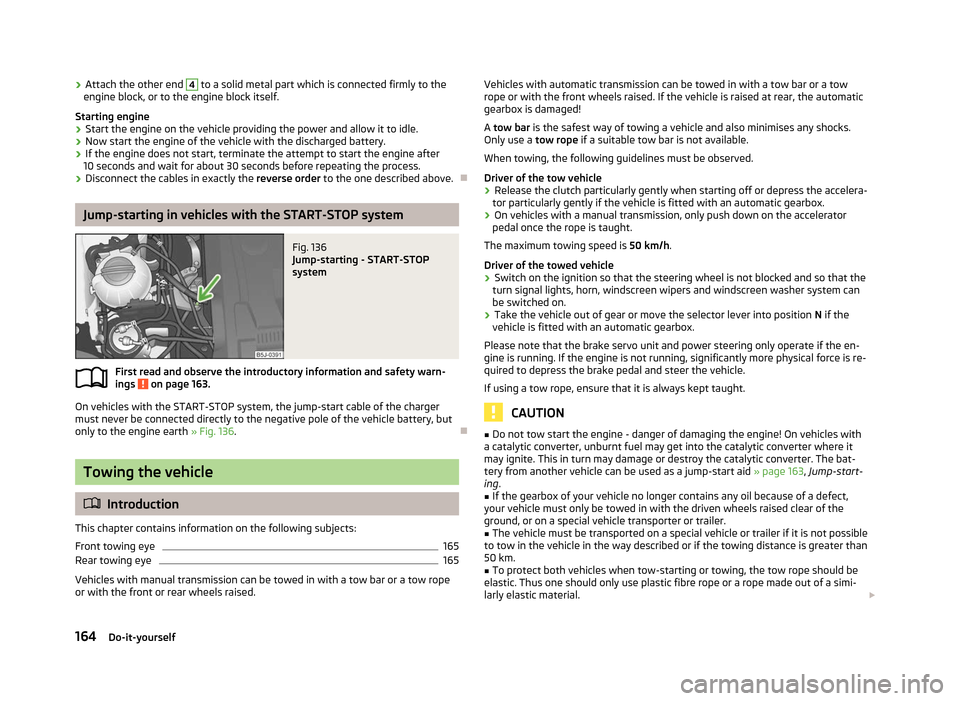
›
Attach the other end 4
to a solid metal part which is connected firmly to the
engine block, or to the engine block itself.
Starting engine
› Start the engine on the vehicle providing the power and allow it to idle.
› Now start the engine of the vehicle with the discharged battery.
› If the engine does not start, terminate the attempt to start the engine after
10 seconds and wait for about 30 seconds before repeating the process.
› Disconnect the cables in exactly the
reverse order to the one described above. ÐJump-starting in vehicles with the START-STOP system
Fig. 136
Jump-starting - START-STOP
system
First read and observe the introductory information and safety warn-
ings on page 163.
On vehicles with the START-STOP system, the jump-start cable of the charger
must never be connected directly to the negative pole of the vehicle battery, but
only to the engine earth » Fig. 136. ÐTowing the vehicle
ä
Introduction
This chapter contains information on the following subjects:
Front towing eye 165
Rear towing eye 165
Vehicles with manual transmission can be towed in with a tow bar or a tow rope
or with the front or rear wheels raised.
ä Vehicles with automatic transmission can be towed in with a tow bar or a tow
rope or with the front wheels raised. If the vehicle is raised at rear, the automatic
gearbox is damaged!
A tow bar
is the safest way of towing a vehicle and also minimises any shocks.
Only use a tow rope if a suitable tow bar is not available.
When towing, the following guidelines must be observed.
Driver of the tow vehicle
› Release the clutch particularly gently when starting off or depress the accelera-
tor particularly gently if the vehicle is fitted with an automatic gearbox.
› On vehicles with a manual transmission, only push down on the accelerator
pedal once the rope is taught.
The maximum towing speed is 50 km/h.
Driver of the towed vehicle
› Switch on the ignition so that the steering wheel is not blocked and so that the
turn signal lights, horn, windscreen wipers and windscreen washer system can
be switched on.
› Take the vehicle out of gear or move the selector lever into position
N if the
vehicle is fitted with an automatic gearbox.
Please note that the brake servo unit and power steering only operate if the en-
gine is running. If the engine is not running, significantly more physical force is re-
quired to depress the brake pedal and steer the vehicle.
If using a tow rope, ensure that it is always kept taught. CAUTION
■ Do not tow start the engine - danger of damaging the engine! On vehicles with
a catalytic converter, unburnt fuel may get into the catalytic converter where it
may ignite. This in turn may damage or destroy the catalytic converter. The bat-
tery from another vehicle can be used as a jump-start aid » page 163, Jump-start-
ing .
■ If the gearbox of your vehicle no longer contains any oil because of a defect,
your vehicle must only be towed in with the driven wheels raised clear of the
ground, or on a special vehicle transporter or trailer.
■ The vehicle must be transported on a special vehicle or trailer if it is not possible
to tow in the vehicle in the way described or if the towing distance is greater than
50 km. ■ To protect both vehicles when tow-starting or towing, the tow rope should be
elastic. Thus one should only use plastic fibre rope or a rope made out of a simi-
larly elastic material. £
164 Do-it-yourself
Page 167 of 194
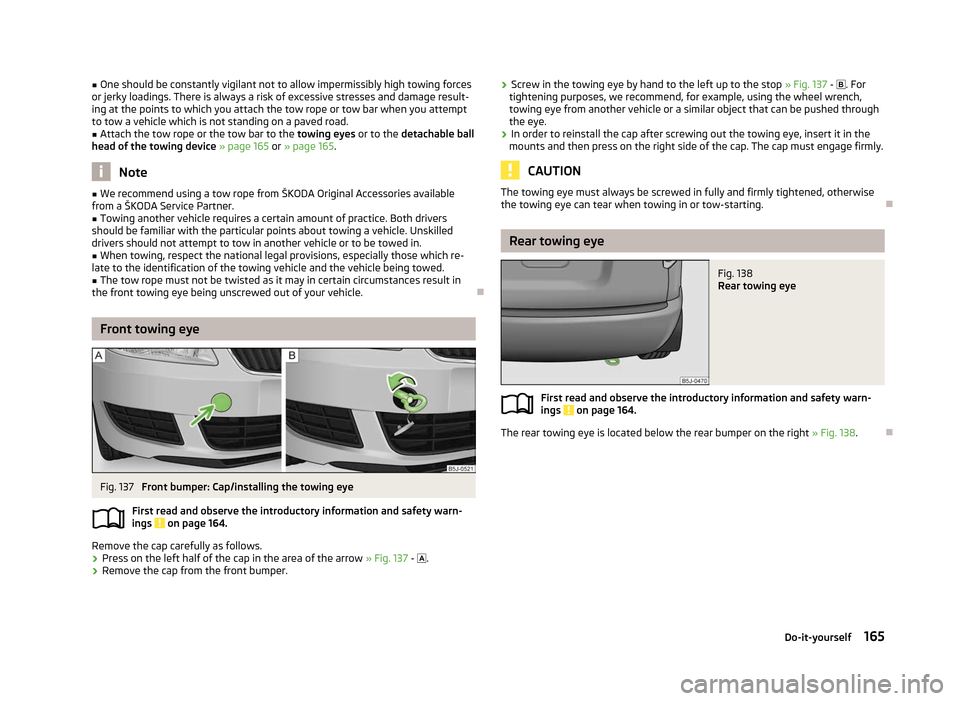
■
One should be constantly vigilant not to allow impermissibly high towing forces
or jerky loadings. There is always a risk of excessive stresses and damage result-
ing at the points to which you attach the tow rope or tow bar when you attempt
to tow a vehicle which is not standing on a paved road.
■ Attach the tow rope or the tow bar to the towing eyes or to the detachable ball
head of the towing device » page 165 or » page 165.Note
■ We recommend using a tow rope from ŠKODA Original Accessories available
from a ŠKODA Service Partner. ■ Towing another vehicle requires a certain amount of practice. Both drivers
should be familiar with the particular points about towing a vehicle. Unskilled
drivers should not attempt to tow in another vehicle or to be towed in. ■ When towing, respect the national legal provisions, especially those which re-
late to the identification of the towing vehicle and the vehicle being towed. ■ The tow rope must not be twisted as it may in certain circumstances result in
the front towing eye being unscrewed out of your vehicle. ÐFront towing eye
Fig. 137
Front bumper: Cap/installing the towing eye
First read and observe the introductory information and safety warn-
ings on page 164.
Remove the cap carefully as follows.
›
Press on the left half of the cap in the area of the arrow
» Fig. 137 - .
› Remove the cap from the front bumper.
ä ›
Screw in the towing eye by hand to the left up to the stop
» Fig. 137 - . For
tightening purposes, we recommend, for example, using the wheel wrench,
towing eye from another vehicle or a similar object that can be pushed through
the eye.
› In order to reinstall the cap after screwing out the towing eye, insert it in the
mounts and then press on the right side of the cap. The cap must engage firmly. CAUTION
The towing eye must always be screwed in fully and firmly tightened, otherwise
the towing eye can tear when towing in or tow-starting. Ð Rear towing eye
Fig. 138
Rear towing eye
First read and observe the introductory information and safety warn-
ings on page 164.
The rear towing eye is located below the rear bumper on the right
»
Fig. 138.Ð ä
165
Do-it-yourself
Page 171 of 194
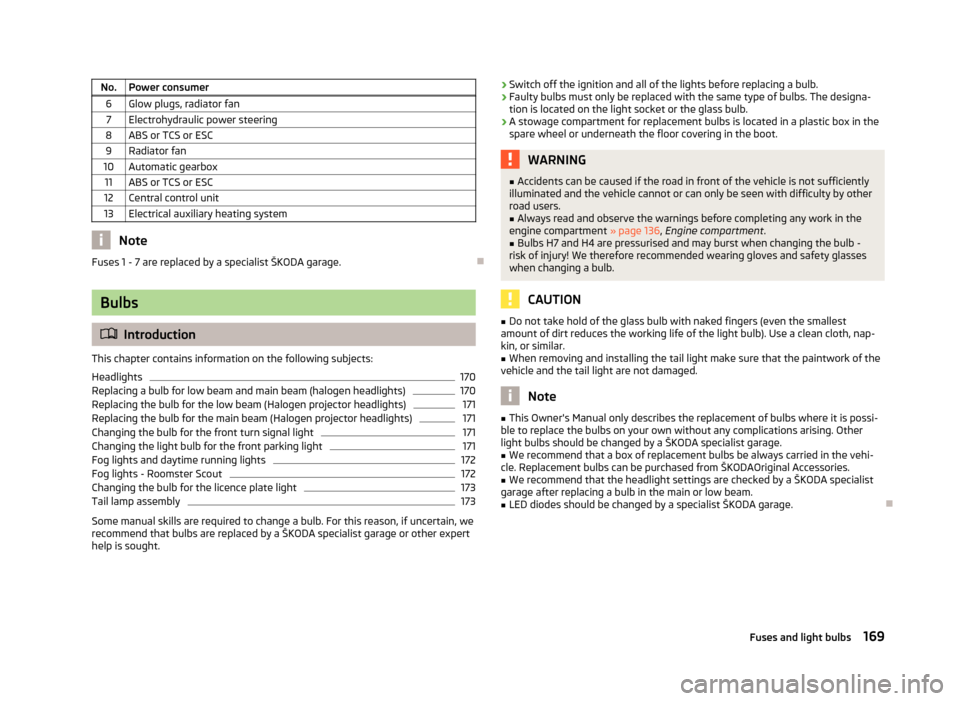
No. Power consumer
6 Glow plugs, radiator fan7 Electrohydraulic power steering
8 ABS or TCS or ESC 9 Radiator fan
10 Automatic gearbox 11 ABS or TCS or ESC
12 Central control unit
13 Electrical auxiliary heating system Note
Fuses 1 - 7 are replaced by a specialist ŠKODA garage. ÐBulbs
ä
Introduction
This chapter contains information on the following subjects:
Headlights 170
Replacing a bulb for low beam and main beam (halogen headlights) 170
Replacing the bulb for the low beam (Halogen projector headlights) 171
Replacing the bulb for the main beam (Halogen projector headlights) 171
Changing the bulb for the front turn signal light 171
Changing the light bulb for the front parking light 171
Fog lights and daytime running lights 172
Fog lights - Roomster Scout 172
Changing the bulb for the licence plate light 173
Tail lamp assembly 173
Some manual skills are required to change a bulb. For this reason, if uncertain, we
recommend that bulbs are replaced by a ŠKODA specialist garage or other expert
help is sought. ›
Switch off the ignition and all of the lights before replacing a bulb.
› Faulty bulbs must only be replaced with the same type of bulbs. The designa-
tion is located on the light socket or the glass bulb.
› A stowage compartment for replacement bulbs is located in a plastic box in the
spare wheel or underneath the floor covering in the boot. WARNING
■ Accidents can be caused if the road in front of the vehicle is not sufficiently
illuminated and the vehicle cannot or can only be seen with difficulty by other
road users.
■ Always read and observe the warnings before completing any work in the
engine compartment » page 136, Engine compartment .
■ Bulbs H7 and H4 are pressurised and may burst when changing the bulb -
risk of injury! We therefore recommended wearing gloves and safety glasses
when changing a bulb. CAUTION
■ Do not take hold of the glass bulb with naked fingers (even the smallest
amount of dirt reduces the working life of the light bulb). Use a clean cloth, nap-
kin, or similar. ■ When removing and installing the tail light make sure that the paintwork of the
vehicle and the tail light are not damaged. Note
■ This Owner's Manual only describes the replacement of bulbs where it is possi-
ble to replace the bulbs on your own without any complications arising. Other
light bulbs should be changed by a
ŠKODA specialist garage.
■ We recommend that a box of replacement bulbs be always carried in the vehi-
cle. Replacement bulbs can be purchased from
ŠKODAOriginal Accessories.
■ We recommend that the headlight settings are checked by a ŠKODA specialist
garage after replacing a bulb in the main or low beam.
■ LED diodes should be changed by a specialist ŠKODA garage. Ð
169
Fuses and light bulbs
Page 177 of 194
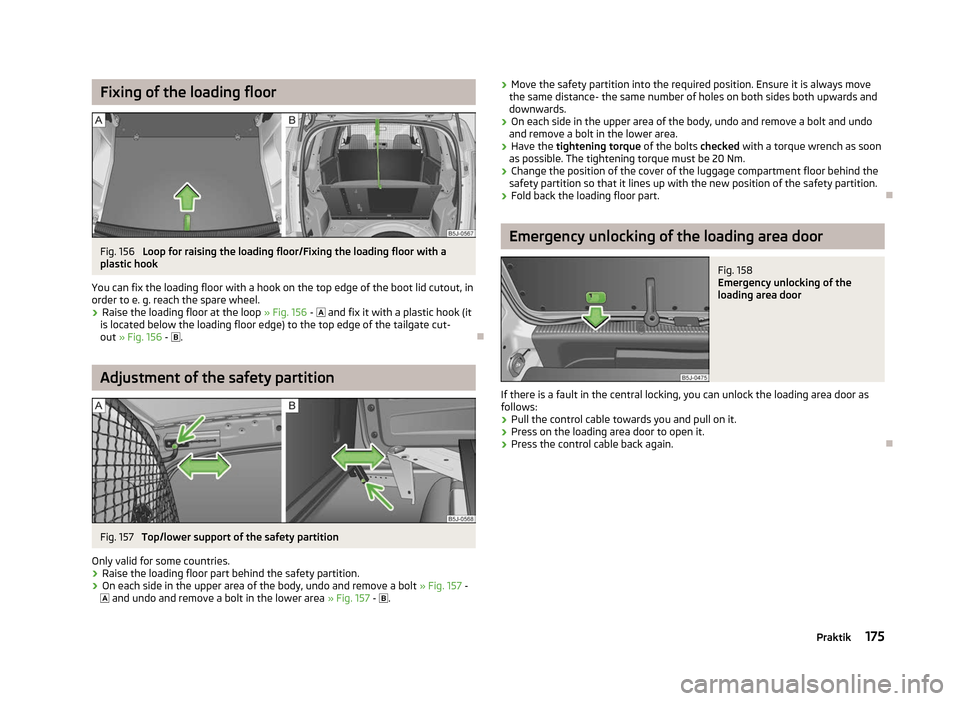
Fixing of the loading floor
Fig. 156
Loop for raising the loading floor/Fixing the loading floor with a
plastic hook
You can fix the loading floor with a hook on the top edge of the boot lid cutout, in
order to e. g. reach the spare wheel.
› Raise the loading floor at the loop
» Fig. 156 - and fix it with a plastic hook (it
is located below the loading floor edge) to the top edge of the tailgate cut-
out » Fig. 156 - . ÐAdjustment of the safety partition
Fig. 157
Top/lower support of the safety partition
Only valid for some countries. › Raise the loading floor part behind the safety partition.
› On each side in the upper area of the body, undo and remove a bolt
» Fig. 157 -
and undo and remove a bolt in the lower area » Fig. 157 - . ›
Move the safety partition into the required position. Ensure it is always move
the same distance- the same number of holes on both sides both upwards and
downwards.
› On each side in the upper area of the body, undo and remove a bolt and undo
and remove a bolt in the lower area.
› Have the
tightening torque of the bolts checked with a torque wrench as soon
as possible. The tightening torque must be 20 Nm.
› Change the position of the cover of the luggage compartment floor behind the
safety partition so that it lines up with the new position of the safety partition.
› Fold back the loading floor part. Ð Emergency unlocking of the loading area door
Fig. 158
Emergency unlocking of the
loading area door
If there is a fault in the central locking, you can unlock the loading area door as
follows:
› Pull the control cable towards you and pull on it.
› Press on the loading area door to open it.
› Press the control cable back again. Ð
175
Praktik
Page 178 of 194
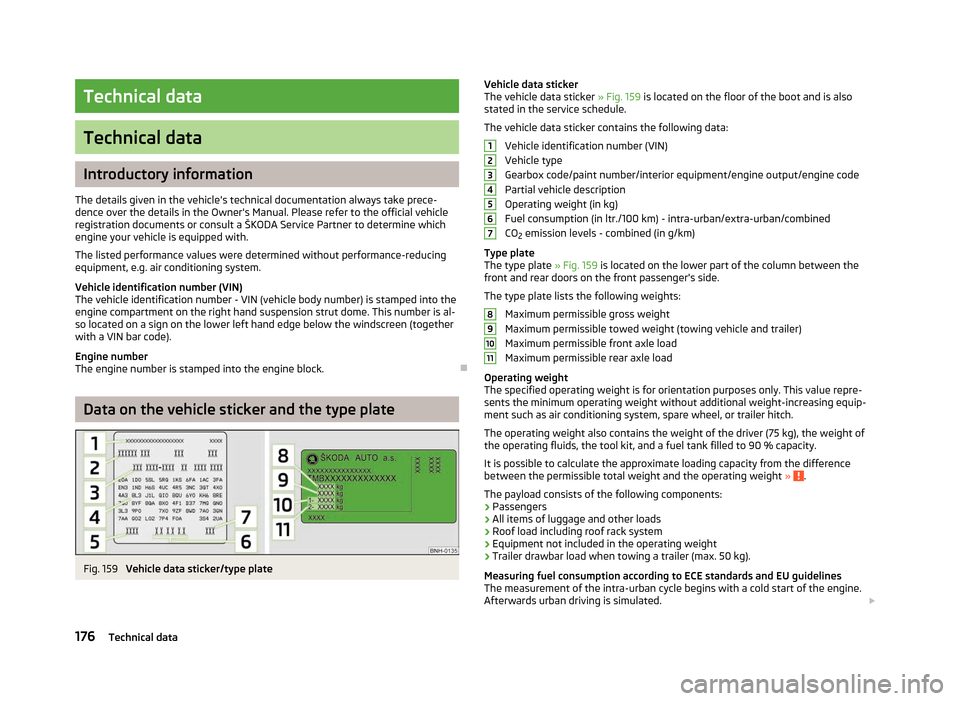
Technical data
Technical data
Introductory information
The details given in the vehicle's technical documentation always take prece-
dence over the details in the Owner's Manual. Please refer to the official vehicle
registration documents or consult a
ŠKODA Service Partner to determine which
engine your vehicle is equipped with.
The listed performance values were determined without performance-reducing
equipment, e.g. air conditioning system.
Vehicle identification number (VIN)
The vehicle identification number - VIN (vehicle body number) is stamped into the
engine compartment on the right hand suspension strut dome. This number is al-
so located on a sign on the lower left hand edge below the windscreen (together
with a VIN bar code).
Engine number
The engine number is stamped into the engine block. ÐData on the vehicle sticker and the type plate
Fig. 159
Vehicle data sticker/type plate Vehicle data sticker
The vehicle data sticker » Fig. 159 is located on the floor of the boot and is also
stated in the service schedule.
The vehicle data sticker contains the following data:
Vehicle identification number (VIN)
Vehicle type
Gearbox code/paint number/interior equipment/engine output/engine code
Partial vehicle description
Operating weight (in kg)
Fuel consumption (in ltr./100
km) - intra-urban/extra-urban/combined
CO 2 emission levels - combined (in g/km)
Type plate
The type plate » Fig. 159 is located on the lower part of the column between the
front and rear doors on the front passenger's side.
The type plate lists the following weights: Maximum permissible gross weight
Maximum permissible towed weight (towing vehicle and trailer)
Maximum permissible front axle load
Maximum permissible rear axle load
Operating weight
The specified operating weight is for orientation purposes only. This value repre-
sents the minimum operating weight without additional weight-increasing equip-
ment such as air conditioning system, spare wheel, or trailer hitch.
The operating weight also contains the weight of the driver (75 kg), the weight of
the operating fluids, the tool kit, and a fuel tank filled to 90 % capacity.
It is possible to calculate the approximate loading capacity from the difference
between the permissible total weight and the operating weight » .
The payload consists of the following components:
› Passengers
› All items of luggage and other loads
› Roof load including roof rack system
› Equipment not included in the operating weight
› Trailer drawbar load when towing a trailer (max. 50 kg).
Measuring fuel consumption according to ECE standards and EU guidelines
The measurement of the intra-urban cycle begins with a cold start of the engine.
Afterwards urban driving is simulated. £ 1
2
3
4
5
6
7
8
9
10
11
176
Technical data
Page 187 of 194
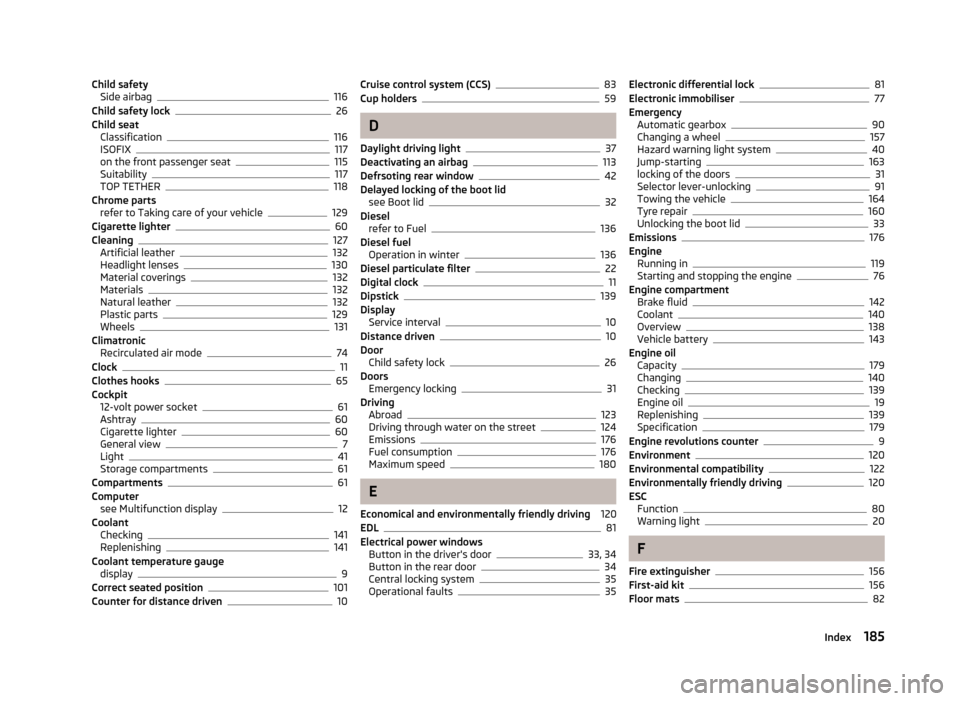
Child safety
Side airbag 116
Child safety lock 26
Child seat Classification 116
ISOFIX 117
on the front passenger seat 115
Suitability 117
TOP TETHER 118
Chrome parts refer to Taking care of your vehicle 129
Cigarette lighter 60
Cleaning 127
Artificial leather 132
Headlight lenses 130
Material coverings 132
Materials 132
Natural leather 132
Plastic parts 129
Wheels 131
Climatronic Recirculated air mode 74
Clock 11
Clothes hooks 65
Cockpit 12-volt power socket 61
Ashtray 60
Cigarette lighter 60
General view 7
Light 41
Storage compartments 61
Compartments 61
Computer see Multifunction display 12
Coolant Checking 141
Replenishing 141
Coolant temperature gauge display 9
Correct seated position 101
Counter for distance driven 10Cruise control system (CCS) 83
Cup holders 59
D
Daylight driving light 37
Deactivating an airbag 113
Defrsoting rear window 42
Delayed locking of the boot lid see Boot lid 32
Diesel refer to Fuel 136
Diesel fuel Operation in winter 136
Diesel particulate filter 22
Digital clock 11
Dipstick 139
Display Service interval 10
Distance driven 10
Door Child safety lock 26
Doors Emergency locking 31
Driving Abroad 123
Driving through water on the street 124
Emissions 176
Fuel consumption 176
Maximum speed 180
E
Economical and environmentally friendly driving 120
EDL 81
Electrical power windows Button in the driver's door 33, 34
Button in the rear door 34
Central locking system 35
Operational faults 35Electronic differential lock 81
Electronic immobiliser 77
Emergency Automatic gearbox 90
Changing a wheel 157
Hazard warning light system 40
Jump-starting 163
locking of the doors 31
Selector lever-unlocking 91
Towing the vehicle 164
Tyre repair 160
Unlocking the boot lid 33
Emissions 176
Engine Running in 119
Starting and stopping the engine 76
Engine compartment Brake fluid 142
Coolant 140
Overview 138
Vehicle battery 143
Engine oil Capacity 179
Changing 140
Checking 139
Engine oil 19
Replenishing 139
Specification 179
Engine revolutions counter 9
Environment 120
Environmental compatibility 122
Environmentally friendly driving 120
ESC Function 80
Warning light 20
F
Fire extinguisher 156
First-aid kit 156
Floor mats 82
185
Index
Page 190 of 194
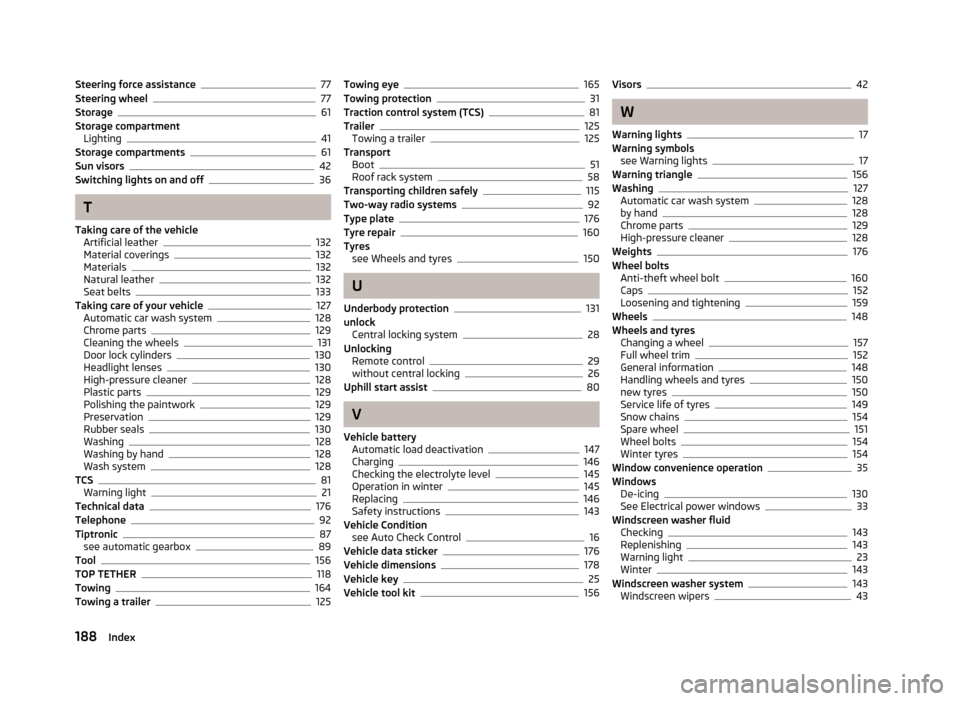
Steering force assistance 77
Steering wheel 77
Storage 61
Storage compartment Lighting 41
Storage compartments 61
Sun visors 42
Switching lights on and off 36
T
Taking care of the vehicle Artificial leather 132
Material coverings 132
Materials 132
Natural leather 132
Seat belts 133
Taking care of your vehicle 127
Automatic car wash system 128
Chrome parts 129
Cleaning the wheels 131
Door lock cylinders 130
Headlight lenses 130
High-pressure cleaner 128
Plastic parts 129
Polishing the paintwork 129
Preservation 129
Rubber seals 130
Washing 128
Washing by hand 128
Wash system 128
TCS 81
Warning light 21
Technical data 176
Telephone 92
Tiptronic 87
see automatic gearbox 89
Tool 156
TOP TETHER 118
Towing 164
Towing a trailer 125Towing eye 165
Towing protection 31
Traction control system (TCS) 81
Trailer 125
Towing a trailer 125
Transport Boot 51
Roof rack system 58
Transporting children safely 115
Two-way radio systems 92
Type plate 176
Tyre repair 160
Tyres see Wheels and tyres 150
U
Underbody protection 131
unlock Central locking system 28
Unlocking Remote control 29
without central locking 26
Uphill start assist 80
V
Vehicle battery Automatic load deactivation 147
Charging 146
Checking the electrolyte level 145
Operation in winter 145
Replacing 146
Safety instructions 143
Vehicle Condition see Auto Check Control 16
Vehicle data sticker 176
Vehicle dimensions 178
Vehicle key 25
Vehicle tool kit 156Visors 42
W
Warning lights 17
Warning symbols see Warning lights 17
Warning triangle 156
Washing 127
Automatic car wash system 128
by hand 128
Chrome parts 129
High-pressure cleaner 128
Weights 176
Wheel bolts Anti-theft wheel bolt 160
Caps 152
Loosening and tightening 159
Wheels 148
Wheels and tyres Changing a wheel 157
Full wheel trim 152
General information 148
Handling wheels and tyres 150
new tyres 150
Service life of tyres 149
Snow chains 154
Spare wheel 151
Wheel bolts 154
Winter tyres 154
Window convenience operation 35
Windows De-icing 130
See Electrical power windows 33
Windscreen washer fluid Checking 143
Replenishing 143
Warning light 23
Winter 143
Windscreen washer system 143
Windscreen wipers 43
188 Index